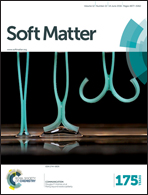Going beyond the classical amphiphilicity paradigm: the self-assembly of completely hydrophobic polymers into free-standing sheets and hollow nanostructures in solvents of variable quality†
Abstract
Self-assembly is well-known to occur in amphiphiles, and the totally hydrophobic ones are never reported to self-assemble. In this work we report for the first time that the latter can self-assemble into free-standing sheets and hollow spheres in toluene/methanol mixed solvents by modulating the solvent quality. The homopolymers studied in this work are polystyrene (PS), polyphenylacetylene (PPA), and poly(3-hexyl thiophene) (P3HT), representing polymers with different rigidity. All the three form a homogenous solution in toluene, but self-assembly occurs in the toluene/methanol mixed solvents. Micrometer sized free-standing sheets were formed for PS, PPA, and P3HT at methanol volume fractions being 43%, 50%, and 67%, respectively, and hollow spheres were observed for PPA at higher methanol fractions of 75 and 90%. Under the latter solvent conditions, PS forms solid spheres, yet ill-defined aggregates and free-standing sheets coexist in the case of P3HT. This non-solvent induced self-assembly was explained by a delicate balance of two “opposing forces”: van der Waals attractive and entropic repulsive forces generated between the segments of these homopolymers within a single chain, between two chains, and among more chains in the solvents of worsened quality.


 Please wait while we load your content...
Please wait while we load your content...